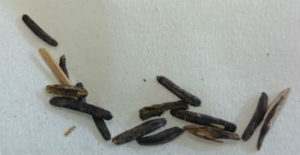Feeding Grain Contaminated With Ergot
15 December 2016 The best advice for grain contaminated with ergot is NOT to feed it to livestock. In particular NEVER feed it to breeding females due to the increased risk to the foetus from even very low levels of ergot. We also strongly recommend that it is not fed to lambs who could be more sensitive, resulting in higher levels of mortality etc.
The best advice for grain contaminated with ergot is NOT to feed it to livestock. In particular NEVER feed it to breeding females due to the increased risk to the foetus from even very low levels of ergot. We also strongly recommend that it is not fed to lambs who could be more sensitive, resulting in higher levels of mortality etc.
If you have grain which is unsellable due to ergot contamination the first step is to estimate what the level of contamination is. This is best achieved by taking a minimum of 10 samples from all over the heap. 1 kg from each sample should then be spread out over a sheet of newspaper and the number of ergots in it counted. These can then be averaged out over all the samples to give a mean ergot count per kg of grain.
Using the maximum ergot contamination allowed under UK law the following table shows the MAXIMUM level of contamination which can be fed to different sizes of cattle (store v finishing) depending on the amount of barley being fed per day.
Assumed Ergot Numbers/Kg Of Grain Fed To Reach Maximum Safe Intake+
Store cattle
| Feed level of grain (kg/day) | Ergot/kg grain |
| 1kg | 1 ergot |
| 2kg | 0.5 ergots |
| 3kg | 0.3 ergots |
Finishing cattle
| Feed level of grain (kg/day) | Ergot/kg grain |
| 2kg | 4 ergots |
| 4kg | 2 ergots |
| 12kg | None |
+ UK legal limit of 0.001% by weight so per 1kg of grain 0.01g of ergot. Rations above are assuming 0.001% over the whole of the animal’s intake. Taking into account the amount of grain as part of the animal’s total daily intake.
For example for a store animals being fed ad-lib silage with just 1 kg of barley per day the maximum level of contamination to avoid breaking UK law would be not more than 1 ergot per kg. Where however the barley was the major feed in the overall ration eg in a barley beef system the maximum would be none.
Health and Safety
- Ergots are extremely poisonous to humans. When handling the grain always wear gloves and a mask. Any household equipment used eg for weighing grain samples etc must be thoroughly washed and preferably put through a dish washer twice.
- Be extremely careful processing grain ie wear full protective clothing, masks, etc. There is evidence that grinding ergot and mixing it in compound feeds increases its toxicity (this means it even more important this winter to ensure purchased feed comes from a reputable source).
Where small amounts are being fed a sensible precaution might be to feed grain whole and avoid the additional risk of processing.
Summary
- Assess as accurately as you can the level of contamination in the grain in terms of ergot pods per kg of grain.
- Only feed to growing/finishing cattle, never to breeding cows or any sheep.
- Never exceed the levels shown in the above table.
- Always feed as little as possible eg by feeding it to more animals. Never feed higher levels to fewer animals – this simply increases the risk.
- Where possible do not process contaminated grain. Feed it whole. Always take full precautions when handling the grain ie protective clothing, masks, etc.
- Monitor stock closely and at the first signs of any of the symptoms in the above article stop feeding contaminated grain immediately.
Basil Lowman, basil.lowman@sac.co.uk
Sign up to the FAS newsletter
Receive updates on news, events and publications from Scotland’s Farm Advisory Service
